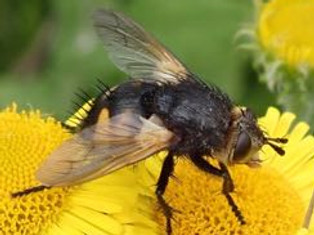
Flies of the forest
Marmalade Hoverflies in Fineshade Wood
An introduction to fly species in Rockingham Forest
by County Recorder, John Showers
True flies (Order Diptera) are not popular with people but they do perform some very important ecological functions, even if a few species are pests. In the UK we have over 7100 species, most of them need expertise to identify, although some are easily recognised. It is not known how many species of fly there are in Rockingham Forest, but a conservative estimate would put it at over 2000 species!
2000 species of flies in Rockingham Forest
True flies are separated from other insects by having only one pair of wings, the forewings. What in other insects are hind wings, in flies these are replaced by small drumstick-like organs called halteres. The halteres act as a means of controlling the orientation of the fly in flight.
The 7100+ species comprise just over 100 families, including familiar ones like
-
hoverflies (family Syrphidae),
-
houseflies (Muscidae),
-
craneflies (Tipulidae, Limoniidae, Pediciidae and Cylindrotomidae) and
-
mosqitoes (Culicidae).

Dictenidia bimaculata, Twin-marked Comb-horn Cranefly.
A notable fly of the forest and a dead wood (saproxylic) species.
It breeds in standing dead wood and logs.
Beneficial flies

Volucella inanis, Wasp Plumehorn Hoverfly.
A species expanding its range northwards. Its larvae live in wasps' and hornets' nests and feed on the wasp larvae.
Parasitic flies
Some groups have parasitic larvae, which kill their hosts. For example, the snail-killing flies (Sciomyzidae) parasitise mainly water snails but also some terrestrial species. The parasitic flies (Tachinidae) parasitise the larvae of other insects, keeping their numbers under control. The woodlouse flies (Rhinophoridae) parasitise woodlice.
Flies and dead wood
There is also a large group of flies that are associated with dead wood, the so-called saproxylic species. These include some of the UK’s rarest species and their presence can indicate high quality woodland habitat. The spectacular Orange-sided Comb-horn Cranefly, Ctenophora pectinicornis is one such species occurring in the ancient woodlands of Rockingham Forest.
Many families of flies are important in pollination of plants. In some cases they can be more important than bees, especially in pollinating fruit trees. Hoverflies are probably the most important in this respect. The larvae of many hoverflies are also major predators of aphids. Other families of fly are major predators of other insects, for example the long-legged flies (Dolichopodidae) and dance flies (Empididae).
Very many families of fly have larvae that feed on rotting or dead organic matter, including dung and dead animals. These are essential in recycling organic matter. Without them we would be wading through all sorts of horrible stuff! In fact some species of blowflies (Calliphoridae) are used by forensic entomologists to determine time of death in police investigations as different species arrive and develop at different stages of decomposition.
.jpg)
Bombylius major, dark-edged bee-fly.
A common Spring species whose larvae parasitise mining bees

This hoverfly, Portevinia maculata, has larvae which mine the bulbs of Ramsons (Wild Garlic). The adult fly can be found when Ramsons are in flower.

The Noon Fly, Mesembrina meridiana, is a common fly in Spring and Autumn. It is often seen sunning itself on leaves or tree trunks. It is a member of the large family of Muscidae, which includes houseflies.

The hoverfly Leucozona lucorum is a common species of Spring and early Summer. It is found in woodland rides visiting a wide variety of flowers.

Xylota silvarum (sometimes called the Golden-tailed Leaf-licker!),Southwick Wood


A bristly fly - Nowickia ferox
On Fleabane in Fineshade Wood
Flesh Fly - one of the Sarcophagidae
in Fineshade Wood

Hoverfly Syrphus ribesii
On Willow in Fineshade Wood

Long Hoverfly - Sphaerophoria scripta
Bedford Purleius
About John Showers
John has been interested in wildlife most of his life but took up studying flies about 20 years ago. He is the Northants County Recorder for Diptera and Membership Secretary for Dipterists Forum, the national society for the study of flies. Like most dipterists, he started with hoverflies, but soon started noticing other types of fly and has gradually expanded his interest over the years.

His favourite fly? The Bumblebee Robberfly, Laphria flava. In the UK it is confined to the Caledonian Pine Forest around Speyside where it is a predator of bees and other larger flying insects.
Interested in invertebrates?
The Northamptonshire Invertebrate group runs field trips throughout the county and is looking for keen invertebrate recorders to come and join them. Beginners looking to learn about recording are also welcome to attend and develop their skills.
More details about the group here